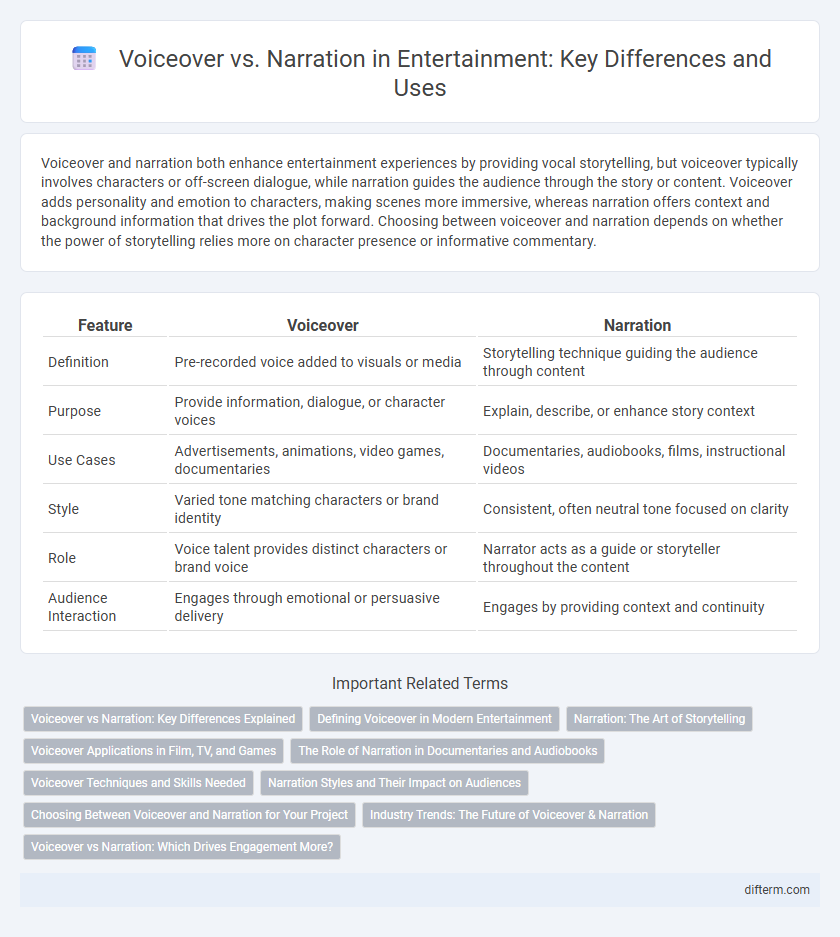Voiceover and narration both enhance entertainment experiences by providing vocal storytelling, but voiceover typically involves characters or off-screen dialogue, while narration guides the audience through the story or content. Voiceover adds personality and emotion to characters, making scenes more immersive, whereas narration offers context and background information that drives the plot forward. Choosing between voiceover and narration depends on whether the power of storytelling relies more on character presence or informative commentary.
Table of Comparison
| Feature | Voiceover | Narration |
|---|---|---|
| Definition | Pre-recorded voice added to visuals or media | Storytelling technique guiding the audience through content |
| Purpose | Provide information, dialogue, or character voices | Explain, describe, or enhance story context |
| Use Cases | Advertisements, animations, video games, documentaries | Documentaries, audiobooks, films, instructional videos |
| Style | Varied tone matching characters or brand identity | Consistent, often neutral tone focused on clarity |
| Role | Voice talent provides distinct characters or brand voice | Narrator acts as a guide or storyteller throughout the content |
| Audience Interaction | Engages through emotional or persuasive delivery | Engages by providing context and continuity |
Voiceover vs Narration: Key Differences Explained
Voiceover and narration both involve spoken content but serve different purposes in entertainment. Voiceover typically refers to off-screen commentary or character voices used in films, commercials, and video games, enhancing storytelling without being part of the scene. Narration guides the audience through the story or documentary by providing context, explanation, or background information, often delivered by a consistent narrator throughout the production.
Defining Voiceover in Modern Entertainment
Voiceover in modern entertainment refers to the technique of providing a non-visible character's voice or commentary over visual media, including films, television shows, and video games. It is distinct from narration by often representing characters, internal thoughts, or guiding audience emotions rather than solely conveying story exposition. Voiceover artists bring scripts to life by using tone, pitch, and emotion to enhance the immersive experience across diverse multimedia platforms.
Narration: The Art of Storytelling
Narration in entertainment serves as the backbone of storytelling, guiding audiences through plot and character development with clarity and emotional depth. Effective narration uses tone, pace, and inflection to immerse listeners, creating vivid imagery and enhancing the narrative experience. Skilled narrators transform scripts into engaging journeys, elevating films, documentaries, and audiobooks beyond mere dialogue into compelling, memorable stories.
Voiceover Applications in Film, TV, and Games
Voiceover in film, TV, and games enhances storytelling by providing character dialogue, inner thoughts, and exposition without on-screen presence. It supports animated features, dubbing, and video game characters, creating immersive experiences through vocal performance. The versatility of voiceover allows seamless integration into diverse formats, enriching narratives and engaging audiences effectively.
The Role of Narration in Documentaries and Audiobooks
Narration in documentaries and audiobooks serves as the primary storytelling vehicle, guiding the audience through complex information with clarity and emotional depth. Unlike voiceover, which often complements visuals or character dialogue, narration functions as a continuous, cohesive thread that connects scenes and sections, enriching the listener's understanding. Professional narrators leverage tone, pacing, and articulation to transform factual content into immersive experiences, enhancing engagement and retention.
Voiceover Techniques and Skills Needed
Mastering voiceover techniques requires precise control of tone, pitch, and pacing to convey emotions effectively while maintaining clarity and engagement. Skilled voiceover artists adapt their vocal delivery to suit various formats such as commercials, animations, and audiobooks, employing breath control and microphone techniques to enhance sound quality. Developing versatility and script interpretation skills allows voice actors to bring characters and narratives to life with authenticity and impact.
Narration Styles and Their Impact on Audiences
Narration styles significantly influence audience engagement by shaping the tone, pace, and emotional resonance of a story. First-person narration fosters intimacy and personal connection, while third-person narration offers a broader perspective and authoritative insight. Voiceover techniques vary from conversational to dramatic, each tailored to enhance the storytelling experience and maintain viewer interest.
Choosing Between Voiceover and Narration for Your Project
Choosing between voiceover and narration depends on your project's needs for engagement and clarity. Voiceover is ideal for adding personality and emotional connection to characters or advertisements, while narration provides a structured, informative guide for documentaries or instructional content. Assess the tone, target audience, and purpose to determine whether a conversational voiceover or a clear, authoritative narration best enhances your message.
Industry Trends: The Future of Voiceover & Narration
The voiceover and narration industry is rapidly evolving with advancements in AI-driven voice synthesis and immersive audio technologies, creating new opportunities for dynamic storytelling. Increasing demand for personalized and multilingual content fuels innovation, pushing voice actors and narrators to diversify their skill sets and embrace digital platforms. Market forecasts indicate continuous growth, driven by expanding sectors such as audiobooks, gaming, virtual reality, and branded content requiring authentic and engaging vocal performances.
Voiceover vs Narration: Which Drives Engagement More?
Voiceover and narration serve distinct roles in entertainment, with voiceovers often adding emotional depth and character to visual content, while narration provides clear storytelling and context. Studies show that voiceovers tend to drive higher engagement by creating a more immersive experience through tone variation and personality. Narration excels in delivering information straightforwardly but may engage less emotionally compared to dynamic voiceover performances.
voiceover vs narration Infographic

 difterm.com
difterm.com